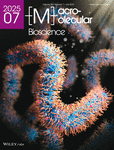Journal list menu
Export Citations
Download PDFs
Cover Picture
Polypept(o)ide-Based Core–Shell Bottlebrush Polymers: A Versatile Platform for Drug Encapsulation
- First Published: 14 July 2025

Front Cover: Cylindrical bottlebrush polymers (CBPs) enable precise control over nanoparticle properties via polymer synthesis. Here, a grafting-from approach utilizing a polylysine backbone enabled the formation of amphiphilic polypept(o)ide-based side chains by sequential NCA-ROP, which provides convenient access to core-shell CBPs. These core-shell architectures combine Dasatinib-loading and sustained release kinetics with cellular uptake and therapeutic efficacy in glioblastoma cells. More details can be found in article 2500083 by Heyang Zhang, Matthias Barz, and co-workers.
Issue Information
Review
Cyclodextrin-Derived Macromolecular Therapies for Inflammatory Diseases
- First Published: 24 April 2025
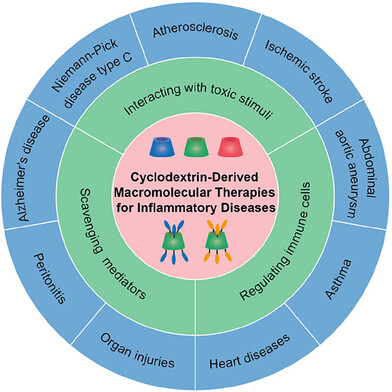
Cyclodextrins (CDs) and their structurally modified derivatives are emerging as promising candidates for anti-inflammatory therapeutics. This review aims to highlight their multifaceted mechanisms of action, therapeutic applications across diverse inflammatory conditions, current translational challenges, and future development opportunities. The integration of current knowledge and identification of critical research gaps facilitates the development of innovative next-generation CD-based anti-inflammatory macromolecules.
Computer-Aided Technology for Bioactive Protein Design and Clinical Application
- First Published: 22 April 2025
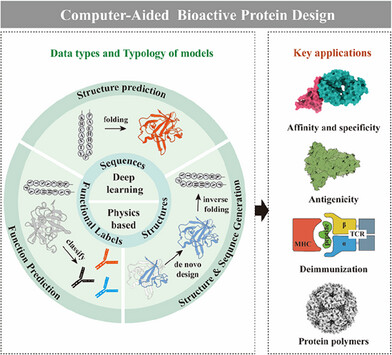
This review highlights computer-aided technologies for bioactive protein design, focusing on deep learning models trained on sequence, structural, and functional data. We classify these models by data modality and modeling objectives, summarizing their roles in improving binding affinity, antigen stability, immunogenicity control, and protein assembly for clinical applications.
Research Article
Polypept(o)ide-Based Core–Shell Bottlebrush Polymers: A Versatile Platform for Drug Encapsulation
- First Published: 22 April 2025

This study developed polypept(o)ide-based core–shell brushes (CSBs) with tunable sizes (Rh: 17–70 nm) for hydrophobic drug delivery. CSBs achieved 10% dasatinib loading through π–π interactions, enabling sustained release over 72 h. Notably, CSB-dasatinib complexes showed comparable cell viability reduction to the free drug in U-87 MG cells, demonstrating its potential for advanced cancer therapy.
Hybrid Poly(Methacrylic Acid-Co-Acrylamide)-Polythiophene Nanofibers for Salivary Diagnosis of Oral Squamous Cell Carcinoma
- First Published: 18 April 2025
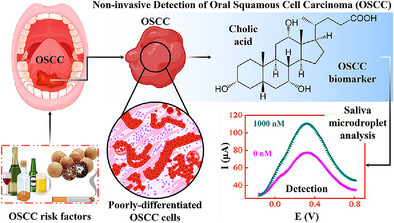
Disposable electrochemical sensors based on hybrid poly(methacrylic acid-co-acrylamide)-polythiophene (CoP-PTh) nanofibers enable the ultrasensitive and selective detection of cholic acid, a key biomarker for oral squamous cell carcinoma (OSCC). The CoP-PTh/SPCE sensor provides a rapid, non-invasive, and cost-effective point-of-care diagnostic tool, improving early OSCC detection using human saliva samples.
Functionalized Hydroxyapatite Loading Enhances the Mechanical and Biodegradation Properties of Wet-Spun Poly(Lactide-co-Glycolide) Scaffolds by Additive Manufacturing
- First Published: 14 April 2025

Computer-aided wet-spinning is employed for the first time to fabricate poly(lactide-co-glycolide) (PLGA) scaffolds loaded with hydroxyapatite (HA). Ceramic particle functionalization through polymer grafting allows enhancing their processing properties, as well as the mechanical behavior and biodegradation resistance of the resulting additively manufactured scaffolds. In addition, the developed composite scaffolds support in vitro preosteoblast viability and differentiation.
Engineering Folic Acid-Modified Nanoparticles to Enhance Letrozole's Anticancer Action
- First Published: 18 April 2025
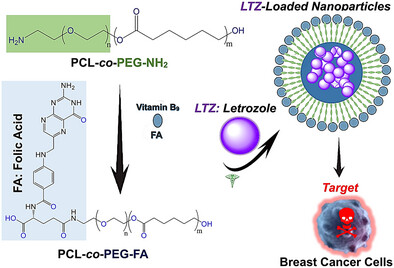
Folate-functionalized, pH-sensitive nanoparticles (NPs) are developed for the targeted delivery of letrozole (LTZ) in breast cancer therapy. LTZ-loaded PCL-co-PEG NPs exhibit controlled release, enhanced cytotoxicity, and apoptosis induction in MCF-7 cells. Functionalization with folic acid improves drug entrapment and release, reducing invasion markers. This biodegradable system offers a promising strategy for selective and efficient cancer treatment.
Drug-Loaded Mitochondrial Targeted Nanoparticles for Tumor Imaging and PDT/PTT Combined Chemotherapy in Muscle-Invasive Bladder Cancer
- First Published: 31 March 2025
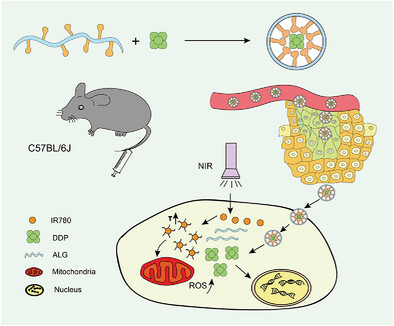
A novel cisplatin-loaded nanoparticle is engineered by conjugating the multifunctional IR780 iodide dye with alginate polysaccharide, enabling precise tumor targeting and potent antitumor activity in muscle-invasive bladder cancer (MIBC). By integrating near-infrared (NIR)-mediated phototherapy with systemic chemotherapy, these nanoparticles enhance drug delivery, tumor imaging, and photothermal effects. This multifunctional approach represents a promising strategy for effective treatment and improved diagnosis of bladder cancer.
Preclinical Testing of 3D Printed, Cell Loaded Hydrogel Based Corneal Substitutes on Rabbit Model
- First Published: 27 March 2025
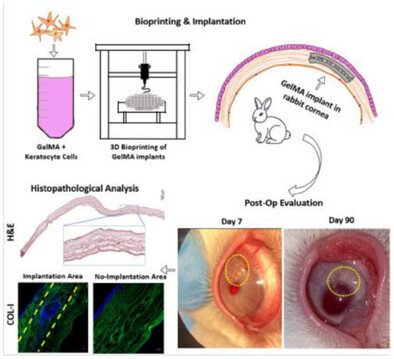
This study reports on 3D-printed methacrylated gelatin (GelMA) implants designed to serve as corneal stroma substitutes. The implants are characterized for their transparency, mechanical strength, and cytocompatibility. In vivo tests on rabbits demonstrate successful integration, with histopathological analysis showing tissue regeneration, appropriate stromal architecture, and multilayered epithelium after 90 days, highlighting the clinical potential of these implants for corneal repair.
Design a Novel Polymeric Heart Valve PHV-SH and Test the Feasibility Using in Vivo Pre-Clinical Non-inferiority Trial
- First Published: 18 April 2025
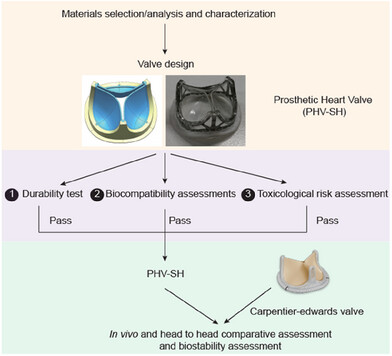
This study presents a novel polymeric heart valve made with innovative SEBS block copolymers, demonstrating outstanding durability, biocompatibility, and hydrodynamic performance. Extensive in vitro and in vivo testing reveals that the valve maintains consistent effective orifice area and low regurgitation, confirming its suitability for long-term use in clinical applications, with strong potential for overcoming challenges posed by traditional bioprosthetic valves.
Chitosan-Based Nanoparticles for Twist1 Knockdown in 4T1 Cells
- First Published: 10 April 2025

Modified chitosan nanoparticles have the potential for passive and active siRNA delivery to different tumors. This study evaluates twist1-siRNA-loaded pegylated chitosan and alendronate-conjugated pegylated chitosan nanoparticles for twist1 gene silencing in 4T1 cells. Twist1 gene silencing is confirmed through delayed wound healing and reduced twist1 protein expression. This shows the potential of these nanoparticles for bone metastasized breast cancer.
A Novel Series of Synthetic Heparin-Mimetics–Itaconic Acid-Containing Copolymers for Targeting Tumor Cell Coagulability and Metastasis
- First Published: 07 April 2025
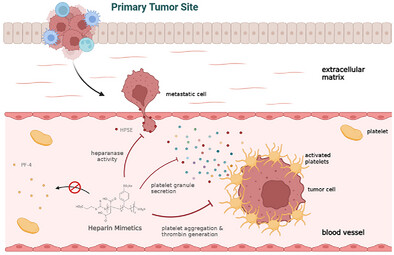
Heparin is postulated to possess antitumor properties- beyond its anticoagulative activities in oncology, but disclosure of targeted activities is complicated by heparins structural variabilities as natural glycosaminoglycans. Here, synthetic noncarbohydrate polymers are presented with tuneable structures as heparin mimetics in in-vitro-approaches for metastatic control. Among different polymer series, poly(SS-co-IA) copolymers outperform heparin in blocking heparanase, reducing platelet activation, while minimizing HIT II risk of heparin.
Coriander-Derived Exosome-Like Nanovesicles Laden Hydrogel with Antioxidant Property Accelerates Wound Healing
- First Published: 02 April 2025
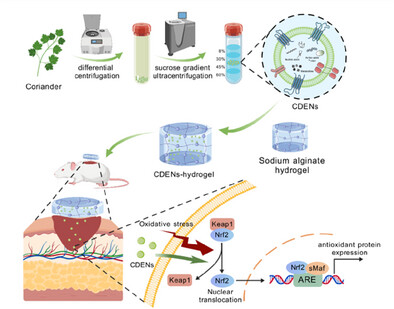
This study presents a novel wound dressing—CDENs-hydrogel, which is fabricated by encapsulating coriander-derived exosome-like nanovesicles (CDENs) in sodium alginate hydrogel. CDENs-hydrogel accelerates wound healing through activating Nrf2 signaling pathway and up-regulating antioxidant protein expression.
Straightforward Approach Toward Thermo-Sensitive Hydrogel Coating on Polyethersulfone Membranes with Controlled Drug Delivery for Significant Inhibition of Thrombocytopenia During Hemodialysis
- First Published: 09 April 2025

Thrombocytopenia is a potential complication associated with hemodialysis due to the unsatisfactory hemocompatibility of current dialysis membranes, which leads to excessive platelet destruction, accelerates organ failure, and threatens the patients’ life safety in severe cases. The work provides a new solution for the preparation of dialysis membranes that can prevent thrombocytopenia, which has potential applications in the safer hemodialysis membrane manufacturing sector.




